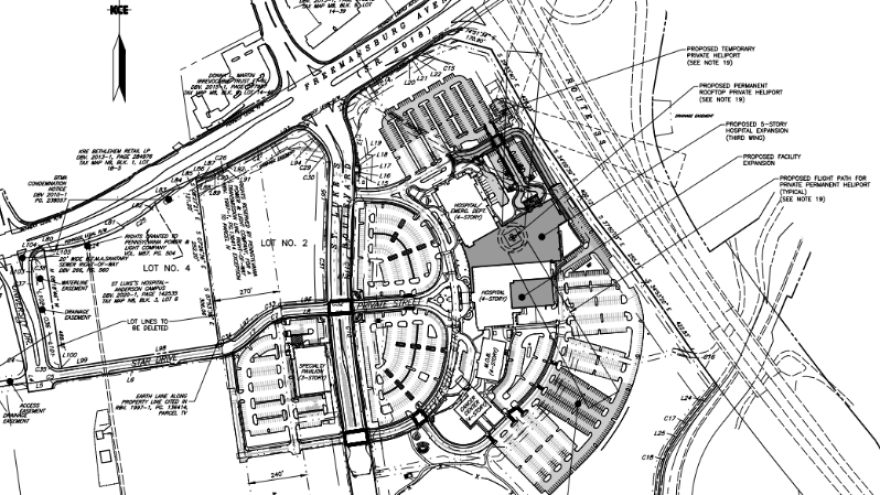- St. Luke's officials are looking to relocate the hospital's helipad if a new building wing is approved
- The temporary helipad would be located over an existing parking lot, and later on the new building
- Township officials approved land development plans for the new hospital wing on Aug. 28
BETHLEHEM TWP., Pa. — As part of a pending third-wing expansion of St. Luke’s University Health Network, hospital officials are looking to temporarily relocate the medevac landing site during construction at the Anderson campus.
Officials and residents shared their thoughts on Monday night regarding the hospital seeking conditional use approval for the relocation.
No official decision was made.
“The goal is to move it temporarily for a time period during construction, then ultimately get it on the roof of the building."Steven Boell, attorney representing St. Luke's
Steven Boell, an attorney for Fitzpatrick Lentz & Bubba who represents St. Luke’s, said the helipad relocation would offer clinical benefits for patients and staff while also lessening the impact on the surrounding community.
“The goal is to move it temporarily for a time period during construction, then ultimately get it on the roof of the building,” Boell said.
The move would be permitted under conditional use approval as long as the developer met specific township guidelines and township commissioners felt there were minimal adverse impacts, according to Boell.
A project manager on Aug. 28 said the temporary helipad would be located over one of the existing parking lots during construction of the new hospital wing. The township planning commission that day approved the expansion’s land development plans calling for a five-story project featuring 146 beds.
The new wing would be located between the existing Women & Babies Pavilion and an existing tower, which is also proposed for expansion. The campus is near the Route 33 interchange at Freemansburg Avenue.
Helipad impacts
Ray Midlam, St. Luke's vice president of business development and strategy, said he's serving as the executive administrative overseeing the project.
The current helipad position would be impacted by the construction of the pending five-story hospital addition, he said.
“Compared to being on the ground, it’s a more controlled environment, safer environment. [It] provides us easier access to the terminal almost immediately when the helicopter arrives, being able to transport the patient directly down the elevator shaft to where they need to be.”Ray Midlam, St. Luke's vice president of business development and strategy
Midlam said the helipad relocation also would make sense considering the hospital campus’ role in the community, offering a neonatal intensive care unit and more.
“Compared to being on the ground, it’s a more controlled environment, safer environment,” Midlam said. “[It] provides us easier access to the terminal almost immediately when the helicopter arrives, being able to transport the patient directly down the elevator shaft to where they need to be.”
Boell then said the township required a minimum of 300 feet from the helipad to any nearby residential uses. Midlam said that the desired helipad location would be over 4,000 feet from properties to the east of the hospital and about 2,500 feet from those to the west.
Safety precautions
Adam Maziuk, St. Luke’s senior director of business development and strategy as well as EMS liaison, said the helipad would be licensed and sized appropriately, feature remote access for landing pad lights, a fuel runoff chamber to contain fuel spills, fire suppression systems and HVAC shutdowns to mitigate smoke exposure if needed.
The overall approval process would go through the township, PennDOT and the Federal Aviation Administration, St. Luke’s officials said.
Commissioner Luke Verdes asked if the potential expansion of the nearby Bethlehem Landfill and relative increase in migratory birds among the chopper paths had been considered during the planning of the new facility.
Boell said that had always been a concern of his client, but the official flight paths are not always going to dictate where the chopper will end up flying.
Thoughts, questions from residents
Midlam said the slight adjustments in helicopter approach paths for the construction period are generally consistent with the official ones approved in 2018.
Resident and township planner Barry Roth later asked for the reasoning behind those path changes, as he said the provided image had the choppers heading over nearby homes.
“The number one priority for the helicopter is the shortest flight, safest flight to land in the shortest time and deliver a patient."Ray Midlam, St. Luke's vice president of business development and strategy
Midlam said the ultimate path of the helicopter can vary, but the approach paths are what pilots follow whenever they’re within about 1,000 yards of the hospital.
“The number one priority for the helicopter is the shortest flight, safest flight to land in the shortest time and deliver a patient,” Midlam explained.
Roth said his neighborhood to the northeast of the campus is in the flight path, later citing what he said were two recent low-flying incidents.
“I didn’t sign on for the house to be shaken,” Roth said.
He added that a failure could be tragic considering the surrounding neighborhoods, and the hospital should use some of its surrounding acreage for the flights instead.
“I didn’t sign on for the house to be shaken."Bethlehem Twp. resident and planner Barry Roth
Commissioner John Merhottien said he lives nearby and has yet to hear a chopper in the hospital’s four or so years offering Medevac facilities.
Resident and planner David Wong agreed with Roth's points, saying that maybe an adjustment in chopper elevation or other flight characteristics could address those issues.


